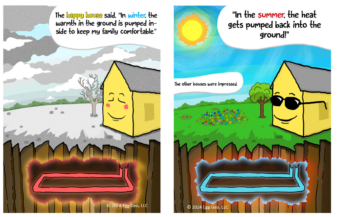Like most contractors in this industry, you are busy trying to build your business, find good employees, keep up with the tax laws and find time for a family life. With all of that going on, you might not be aware that there has been a push in the industry to migrate to flammable refrigerants in the near future. That’s right, flammable refrigerants are being planned for nearly every refrigeration application currently available, including home residential direct-system air conditioners.
You might be asking yourself, who in their right mind would put contractors and technicians through this phasedown-hell again? Afterall they have already lived through this nightmarish movie more times than they can count. Even though the HVACR industry’s refrigerants were not the biggest culprit in depleting the ozone layer, it has paid the price for it more than any other industry in the world and it is easy to target at the counter where it is purchased. In the 90’s it was R12, one of the worst ozone depleting substances. Then, turn the clock to 2010, when the production and import of R22 was prohibited. By 2020, R22 will essentially no longer be allowed. Then add 134a and 410 to the list of those being phased down and out. They always seem to say it is going to be simple, but you never feel the same intensity of pain when it is just a memory. There are not “drop-in” replacements, always some retrofitting and oil changes.

Sure, 410 was more efficient than the others. Yes, it was better for the environment…again. Some say it was also much less expensive than 22, but that may have been after it was gathered and hoarded by those resisitng the change. There were some negative aspects as well. The pressures were much higher than previous systems. In fact, as much as 10 times more than some of the legacy systems. It required more retrofits, replacements, tools, gauges and training for your technicians.
“You might be asking yourself, who in their right mind would put HVACR contractors and technicians through this phasedown-hell again?”
Surely it has to be the environmentalists and the EPA again, right? The industry has carried the cost of the depleting ozone on its back for decades so it can’t be a business interest driving this bus. The environmentalists don’t seem to be at the point of the spear and might rideshare, but they are asking for a phase-down rather than a phase-out and aiming for a later date. Instead, a few of your equipment and refrigerant manufacturers are involved and have been working very hard to push code regulation and legislation immediately to phase out the refrigerants currently used across the US and replace them with Lower Global Warming Potential (Low GWP) refrigerants.
They have stated that they are “under the gun” to migrate to these flammable refrigerants right away. When explored further though, you will find that there is no actual regulation that sets a deadline. A couple manufacturers have vigorously pursued changes in the 2018 International and Uniform Mechanical Codes, even though the standards and testing weren’t even close to completion. They have created a self-imposed deadline! The Department of Energy is implementing new energy conservation regulations but they are not related to the environmental ozone depletion issues. Once approved by DOE, the energy efficiency improvements will go into effect January 1, 2023, and will adjust based on changes to product test procedures and protocols. It could be that manufacturers have to re-engineer product lines for new energy efficiency requirements anyway so why not add new Low GWP refrigerants at the same time? It’s much more cost-effective for them to do it once, thus, their self-push to get flammable refrigerants approved in the codes and standards sooner rather than later.
TYPICAL ORDER OF EVENTS 1.Research 2. Standards 3. Codes …in this instance, it is opposite and the cart is being placed before the horse…
If you are a half-full personality, you might just be saying, “I have done it a couple times already, so I can do it again. After-all my people are the best trained and most professional cutting edge technicans in our market.” Hold that positive thought because you are going to need that confidence as you learn more about the characteristics of the the new Low GWP systems.
Here is the first catch – they are flammable. Most likely the system will not be the cause of the fire, but they are a stored fuel. Not only are they flammable, they have the same high pressures as a typical 410 system. Yes, you will be selling your customers, friends and family high pressure flammable refrigeration systems. No, it is not high pressure propane and it is not a bomb, but a pilot light, spark or candle can ignite it. It is designated as a lower flammability refrigerant, or A2L. One more complication is that it does not have an odorant like natural gas and propane to warn when a leak occurs. Special precautions need to be taken.
Here is the first catch, the new Low Global Warming Potential (LOW GWP) refrigerants are flammable.
Almost all refrigerants produce HF when introduced to a direct flame. Typically it would be a minimal amount because it tends to occur where the flame edge meets or impinges on the refrigerant leak and a cloud of A1 refrigerant would not ignite and burn. In stark contrast, when A2L refrigerants are introduced to flame, they will ignite, burn completely and produce hydrofluoric acid. HF is highly corrosive and is considered a contact poison. Because it can penetrate tissue, poisoning can occur readily through exposure of skin or eyes, or when inhaled or swallowed. It is extremely dangerous. First responders will need to have new personal protective equipment and be properly trained to mitigate a fire incident.
In order to reduce the danger after an A2L leak, a reliable leak detection device is critical to warn occupants of the inherent danger. Currently though, robust and reliable refrigerant detection technology doesn’t exist for this specific application. Sensors utilized in A2L units will require regular calibration in shorter intervals, most likely less than a year, and will be exposed to much harsher residential and light commercial environmental conditions than those in use today. The proposed detection mitigation solution is not available at this time.
A reliable leak detection device is critical to warn occupants of an A2L leak in their direct systems, but the proposed sensor technology is not yet available at this time.
The industry codes and standards agencies, associations and research bodies are making big strides to perform the critical testing of the systems, develop important safety and technical requirements and provide for safe installations of flammable refrigerants. The American Society of Heating Refrigeration and Airconditioning Engineers (ASHRAE) has been updating the standard (ASHRAE 15) for quite some time and A2L provisions have been added. Underwriters Labratories (UL) is working on the equipment listing standard so that manufacturers can test and certify their equipment and the Air-conditioning, Heating and Refrigeration Institute (AHRI) is performing the important research and tests to base the standards upon.
There is no need to choose one side or the other, afterall, it is not an all-or-nothing proposition. It is a matter of time until A2L refrigerant containing equipment will be installed. Great progress is being made but there is a lot of debate as to whether the cart is being placed before the horse and critical mechanical code and standard requirements are being rushed out before the research is complete nd all industry stakeholders, especially the fire fighters and technicians that will be most affected. On one side, some manufacturers are deeply invested and are driving hard to get the standards completed to meet code deadlines, while others in the industry want to be sure that all testing and research has been completed before writing regulation into stone. Every stakeholder must agree not to rush to market as the safety of the the public, technicians and first responders is at stake.
Most importantly, don’t rush it before the research is complete and the fire service and all HVACR interests are engaged. There is more than just a livelihood at stake!
Yes, it can be a viable method to accomplishing the goals of the EPA, the manufacturers and the industry overall. They can be safely installed and maintained. With time, the right standards and code provisons can be put in place. Although there is no training available today, technicians have always been top notch and will be trained to install these systems correctly and safely. Detectors will become reality because the market will demand them. Firefighters will be educated on the the dangers of HF after a refrigertion ignition. In fact, with a little time, more manufacturers will find other ways to meet the environmental goals safely.
Until then, there are lives and livelihoods at stake. Do your homework. It is not too late to make a call, instill your will and offer your expertise. Yes, there has been a lot of experts working on this issue but the contracting and technician point of view has been minimal. Contact your contractor association, code development organizations and standards agencies and demand a seat at the table. It is your industry!
Demand a seat at the table or prepare to be on the menu!
For more information, technical data, committee and organization contacts or to send your comments, contact Jay@BuildingCodesAndStandards.com
IMPORTANT: Please spread awareness by sharing this column across all of your networks.
 About the author: Jay Peters has been in the HVACR industry for more than 30 years as a licensed refrigeration journeyman, sheetmetal installer and HVAC contractor in New Mexico, Arizona, Kansas, Washington D.C. and the state of Maryland. For more than a decade he worked for the two largest code organizations as Executive Director of plumbing, mechanical and fuel gas at the International Code Council (ICC) and Senior Director of Codes and Education at the International Asssociation of Plumbing and Mechanical Officials (IAPMO). Currently he is a voting member of ASHRAE Standard 15, the Air Conditioning Contractors of America’s national code committee and the principal advisor at Codes and Standards International.
About the author: Jay Peters has been in the HVACR industry for more than 30 years as a licensed refrigeration journeyman, sheetmetal installer and HVAC contractor in New Mexico, Arizona, Kansas, Washington D.C. and the state of Maryland. For more than a decade he worked for the two largest code organizations as Executive Director of plumbing, mechanical and fuel gas at the International Code Council (ICC) and Senior Director of Codes and Education at the International Asssociation of Plumbing and Mechanical Officials (IAPMO). Currently he is a voting member of ASHRAE Standard 15, the Air Conditioning Contractors of America’s national code committee and the principal advisor at Codes and Standards International.
About Codes and Standards International: A leading global consultancy assisting manufacturers to test, certify and list products while simultaneously implementing successful strategies for codes and standards acceptance and industry recognition. CSI advocates client interests around the world at code and technical standard meetings and product review and regulatory hearings. The consultancy’s diverse client folio includes Fortune 500 companies, small family owned manufacturers, not for profit associations and international development agencies.



